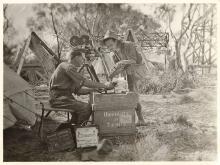Listen to today's episode of StarDate on the web the same day it airs in high-quality streaming audio without any extra ads or announcements. Choose a $8 one-month pass, or listen every day for a year for just $30.
You are here
Moon and Saturn
After cozying up to the solar system’s biggest planet a couple of nights ago, the Moon sets its sights on the second-biggest planet tonight. Saturn looks like a bright star to the left of the Moon as darkness falls. It’ll stand even closer above the Moon as they set in the wee hours of the morning.
The Moon can appear close to both worlds because all three bodies follow roughly the same path across the sky. It’s known as the ecliptic. Technically, it marks the Sun’s path. But the Sun’s major planets all stay within a few degrees of the ecliptic, and so does the Moon. So the Moon passes close to Jupiter and Saturn every month.
Saturn’s orbit is tilted by about two and a half degrees. That means the planet never appears farther from the ecliptic than roughly the width of your finger held at arm’s length. The Moon’s orbit is tilted by about five degrees. So some months, the Moon passes above Saturn, and some months it passes below.
Occasionally, though, their paths precisely overlap. When that happens, the Moon passes in front of Saturn, briefly blocking the planet from view.
Such an event is known as an occultation. And the next one is coming up in November. It won’t be visible from the United States, though. Instead, it’ll highlight the skies of Australia, New Zealand, and some islands in the Southern Ocean — a disappearing act made possible by the clockwork precision of the solar system.
Tomorrow: A fiery birth for an ancient Sun god.






